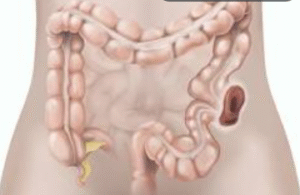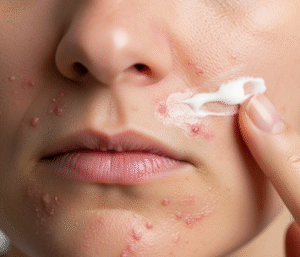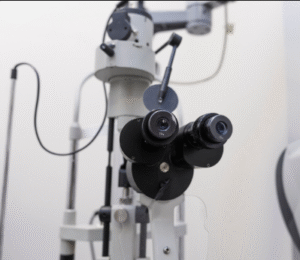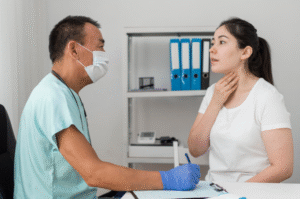What It Is
Defining Keloid Scars
→ A keloid scar forms when the skin’s natural healing process becomes overactive, producing excess collagen.
→ Unlike normal scars, keloids do not stop growing once the wound has healed. They may continue to thicken, darken, and spread over time.
→ They are most common after acne, burns, piercings, surgical wounds, or injuries.
Key Characteristics
- Firm, rubbery texture
- Reddish, pink, or darker than surrounding skin
- May be itchy or painful
- Can occur anywhere but often found on chest, shoulders, jawline, and earlobes
Why It’s Done
Main Reasons for Seeking Treatment
➡ Aesthetic Concerns – Many patients feel self-conscious about visible keloids, especially on the face or exposed body parts.
➡ Physical Discomfort – Keloids can cause constant itching, burning sensations, or pain.
➡ Movement Restriction – When large, they may limit mobility, particularly around joints.
➡ Emotional Well-being – Treating keloids helps restore confidence and reduces anxiety or stress linked with appearance.
Alternatives
Non-Medical Options
- Camouflage Makeup → Temporary concealment of color and texture irregularities.
- Silicone Sheets or Gels → Used as first-line prevention and management for small or new scars.
Medical Alternatives
→ If traditional therapies are unsuitable, patients may consider:
- Cryotherapy (freezing scar tissue with liquid nitrogen)
- Pressure Therapy (especially for ear piercings, using pressure earrings)
- Topical Steroids or ointments for mild cases
Preparation
Before Treatment
➡ Consultation – A dermatologist will examine the keloid, its size, thickness, and location.
➡ Medical History – Patients should inform doctors of past treatments, skin conditions, and healing tendencies.
➡ Skin Preparation – Depending on the chosen treatment, the skin may need to be kept moisturized or treated with pre-conditioning creams.
➡ Avoid Sun Exposure – Sun can darken scars, making treatment more difficult.
➡ Psychological Preparation – Keloid treatment often requires multiple sessions; patients must understand it is a gradual process, not a one-time fix.
How It’s Done
Common Treatment Methods in Korea
1. Corticosteroid Injections
→ The most widely used treatment.
- Steroid injections are delivered directly into the keloid.
- They work by reducing inflammation, flattening the scar, and relieving itching.
- Sessions are repeated every 3–6 weeks.
2. Laser Therapy
→ Fractional or pulsed-dye laser is common in Korea.
- Helps reduce redness and smooth texture.
- Often combined with injections for best results.
3. Surgical Excision
→ Used for large keloids.
- The keloid is surgically removed, but recurrence is common.
- Usually combined with radiation therapy or steroid injections afterward to prevent regrowth.
4. Cryotherapy
→ Liquid nitrogen freezes and destroys scar tissue.
- More effective for smaller keloids.
- May lighten skin in darker skin tones.
5. Radiation Therapy
→ Used immediately after surgery to reduce recurrence.
- In Korea, low-dose superficial radiation is considered effective and safe.
6. Pressure Therapy
→ Often used for earlobe keloids.
- Special pressure earrings prevent regrowth after removal.
Recovery
Immediate Recovery
- Steroid Injections → Mild soreness at injection site; usually manageable with cold compress.
- Laser Treatment → Redness and swelling for 1–2 days, then gradual improvement.
- Surgery → Requires wound care; stitches removed after 7–14 days.
- Cryotherapy → Temporary blistering or swelling that heals within a week.
Long-Term Recovery
→ Keloid treatment is about management, not cure. Even after successful flattening, scars must be monitored to prevent recurrence.
→ Patients are often advised to use silicone gels, sunblock, and moisturizing creams during recovery.
Complications
Possible Risks
- Recurrence → The biggest challenge with keloids is that they can return, sometimes larger than before.
- Skin Discoloration → Especially after cryotherapy or radiation, skin may appear lighter or darker.
- Infection → Rare but possible after surgical excision.
- Pain and Sensitivity → Temporary discomfort after injections or laser therapy.
- Thickened Tissue → In some cases, treatment may leave hardened scar tissue.
Treatment Options in Korea
Advanced Dermatology and Cosmetic Care
South Korea is globally recognized for its dermatology expertise and advanced cosmetic technology. Keloid scar treatment is no exception, with many clinics offering multi-modal approaches for the best outcome.
Why Korea is a Leading Destination
➡ State-of-the-art laser technology used in combination with other therapies
➡ Experienced dermatologists specializing in scar management
➡ Comprehensive care plans – including prevention, treatment, and long-term monitoring
➡ Focus on minimizing recurrence rather than just removal
Popular Methods in Korea
- Combination of steroid injections + laser for better flattening and color correction
- Surgical removal + radiation for severe or recurring keloids
- Custom-made silicone patches and pressure earrings for ear keloids
- Advanced cryotherapy with minimal pigment change for darker skin tones
Patient Experience in Korea
- Clinics often emphasize comfort and follow-up care
- Treatments are typically performed in outpatient settings
- Korean clinics offer personalized scar management programs that include aftercare products and lifestyle guidance
Conclusion
Keloid scar treatment in Korea is a multi-layered, patient-centered process that combines medical expertise, advanced technology, and ongoing care. While keloids are stubborn and prone to recurrence, Korean dermatologists excel at tailoring treatment plans that reduce thickness, improve texture, and minimize discomfort.
Patients considering keloid scar treatment in Korea can expect a comprehensive, high-quality approach that blends medical precision with cosmetic excellence—making it one of the best destinations for managing this challenging skin condition.













